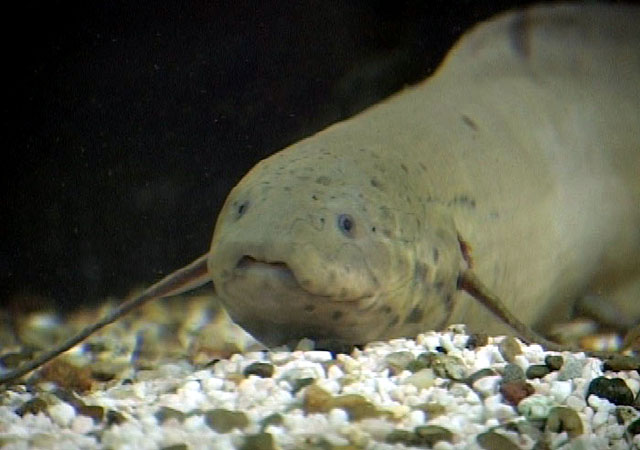| Protopteridae (African lungfishes) |
| 130 cm TL (male/unsexed); max.weight: 11 kg |
|
demersal; freshwater |
| Africa: widespread in the lower and middle Congo River basin (Ref. 3498, 40587, 81627, 104724). Also known from the Ogowe, Kouilou-Niari and Loeme rivers (Ref. 3498, 40587, 81627). |
|
Diagnosis: Body cylindrical and more elongate than in other Protopterus species (Ref. 81627). Pectoral and pelvic fins filamentous (Ref. 40587). About 85-95 scales on the longitudinal line between operculum and anus (Ref. 104724).
Description: Anguilliform body (Ref. 46852). Head length 8,5-13,0 % of total length (Ref. 81627). Eyes are small, the diameter 4,5-9,5% of head length (Ref. 81627). Three gills on each side, but absent in specimens larger than 500 mm total length (Ref. 40587, 81627). Caudal fin pointed and confluent with the dorsal and anal fins; pectoral fins, 20,5-39.0% of preanal distance and often with a basal fringe, can reach twice the head length; pelvic fins, 17,6-26,9% of preanal distance, are a little shorter than the pectoral fins (Ref. 81627). The anus is positioned either on the right or left side of the body (Ref. 81627). Cycloid scales (Ref. 46852): 80-104 scales in longitudinal line in front of the pelvic fin; 40-48 scales around the body (Ref. 40587, 81627). Number of ribs: 47-55 (Ref. 41465, 81627).
Colouration: Overall brownish or greyish (Ref. 81627). Young have black spots dorsally and on the flanks; in adults this spotting is reduced or absent anteriorly and in large specimens disappears completely (Ref. 40587, 81627). The sensory canals on the head and the body are paler than the remainder of the body (Ref. 1878, 81627). |
| Protopterus dolloi is not aestivating in cocoons during the dry-season, because the habitat in which it lives is never completely dry (Ref. 81627); although it never lost the capability to aestivate (Ref. 40587). Therefore, the tunnel which it digs is not for hibernation but functions as a protected chamber during reproduction, which takes place in the dry season (Ref. 81627). The male guards the eggs and larvae in the nest, which is built in the mud of the swamps, while the females can be found in the open water of the rivers (Ref. 41587, 81627). The food of Protopterus dolloi are fishes and insects, but during the time of reproduction its food is more vegetarian (Ref. 40587, 46852). |
|
Least Concern (LC); Date assessed: 16 February 2009 Ref. (130435)
|
| harmless |
Source and more info: www.fishbase.org. For personal, classroom, and other internal use only. Not for publication.

